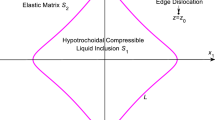The three-dimensional problem of load transfer between an unbounded matrix and an arbitrarily shaped inclusion that are in sliding contact is solved using the theory of elasticity and the boundary-element method. The interface conditions are implicitly incorporated into a system of six boundary integral equations, which are regularized and discretized over a boundary-element mesh. A short cylindrical fiber with rounded ends is considered as an example of inclusion to study the contact forces on its surface and the displacements and stresses inside it in a matrix subject to uniform compression at infinity
Similar content being viewed by others
References
J. D. Eshelby, “Continuum theory of lattice defects,” in: F. Seitz and D. Turnbull (eds.), Progress in Solid State Physics, Vol. 3, Academic, New York (1956), pp. 79–144.
J. Balas, J. Sladek, and V. Sladek, Stress Analysis by Boundary Element Methods, Elsevier, Amsterdam (1989).
A. N. Guz, “Three-dimensional theory of stability of a carbon nanotube in a matrix,” Int. Appl. Mech., 42, No. 1, 19–31 (2006).
A. N. Guz and J. J. Rushchitsky, “Analysis of structurally complex nanocomposites (review),” Int. Appl. Mech., 47, No. 4, 351–409 (2011).
I. Jasiuk, J. Chen, and M. F. Thorpe, “Elastic moduli of composites with rigid sliding inclusions,” J. Mech. Phys. Solids, 40, No. 2, 373–391 (1992).
V. I. Kushch, “Multipole expansion method in micromechanics of composites,” in: M. Kachanov and I. Sevostianov (eds.), Effective Properties of Heterogeneous Materials, Springer, Dordrecht (2013), pp. 97–197.
M. P. Lutz and R. W. Zimmerman, “Effect of an inhomogeneous interphase zone on the bulk modulus and conductivity of a particulate composite,” Int. J. Solids Struct., 42, 429–437 (2005).
V. V. Mikhas’kiv and B. M. Stasyuk, “Numerical solution of three-dimensional static problems of elasticity for a body with a noncanonical inclusion,” Int. Appl. Mech., 43, No. 4, 380–387 (2007).
T. Mura, I. Jasiuk, and B. Tsuchida, “The stress field of a sliding inclusion,” Int. J. Solids Struct., 21, No. 12, 1165–1179 (1985).
Z. Zhong, X. B. Yu, and S. A. Meguid, “3D micromechanical modeling of particulate composite materials with imperfect interface,” Int. J. Multiscale Comp. Eng., 2, No. 1, 79–94 (2004).
K. Zhou, H. J. Hoh, X. Wang, L. M. Keer, J. H. L. Pang, B. Song, and Q. J. Wang, “A review of recent works on inclusions,” Mech. Mater., 60, No. 1, 144–158 (2013).
Author information
Authors and Affiliations
Corresponding author
Additional information
Translated from Prikladnaya Mekhanika, Vol. 51, No. 6, pp. 42–51, November–December 2015.
Rights and permissions
About this article
Cite this article
Mikhas’kiv, V.V., Stasyuk, B.M. Elastic State of a Sliding Short Fiber Inclusion in a Three-Dimensional Matrix. Int Appl Mech 51, 640–647 (2015). https://doi.org/10.1007/s10778-015-0720-8
Received:
Published:
Issue Date:
DOI: https://doi.org/10.1007/s10778-015-0720-8




